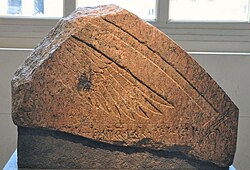

The Suez inscriptions of Darius the Great were texts written in Old Persian, Elamite, Babylonian and Egyptian on five monuments erected in Wadi Tumilat, commemorating the opening of the "Canal of the Pharaohs" between the Nile and the Bitter Lakes.
One of the best preserved of these monuments was a stele of pink granite, which was discovered by Charles de Lesseps, Ferdinand de Lesseps's son, in 1866, 30 kilometres from Suez near Kabret in Egypt. It was erected by Darius the Great, king of the Achaemenid Empire (or Persia), whose reign lasted from 522 to 486 BCE. The monument, also known as the Chalouf stele (alt. Shaluf Stele), records the construction of a forerunner of the modern Suez Canal by the Persians, a canal through Wadi Tumilat, connecting the easternmost, Bubastite, branch of the Nile with Lake Timsah, which was connected to the Red Sea by natural waterways. The stated purpose of the canal was the creation of a shipping connection between the Nile and the Red Sea, between Egypt and Persia.
Text
Partial transliteration and translation of the inscription:
- Transliteration of the Old Persian text:
xâmanišiya \ thâtiy \ Dârayavauš \ XŠ \ adam \ Pârsa \ amiy \ hacâ \ Pâ rsâ \ Mudrâyam \ agarbâyam \ adam \ niyaštâyam \ imâm \ yauviyâ m \ katanaiy \ hacâ \ Pirâva \ nâma \ rauta \ tya \ Mudrâyaiy \ danuvatiy \ ab iy \ draya \ tya \ hacâ \ Pârsâ \ aitiy \ pasâva \ iyam \ yauviyâ \ akaniya \ avathâ \ yathâ \ adam \ niyaštâyam \ utâ \ nâva \ âyatâ \ hacâ \ Mudrâ yâ \ tara \ imâm \ yauviyâm \ abiy \ Pârsam \ avathâ \ yathâ \ mâm \ kâma\ âha
- English translation:
"King Darius says: I am a Persian; setting out from Persia I conquered Egypt. I ordered to dig this canal from the river that is called Nile and flows in Egypt, to the sea that begins in Persia. Therefore, when this canal had been dug as I had ordered, ships went from Egypt through this canal to Persia, as I had intended."
See also
References
- William Matthew Flinders Petrie, A History of Egypt. Volume 3: From the XIXth to the XXXth Dynasties, Adamant Media Corporation, ISBN 0-543-99326-4, p. 366
- Barbara Watterson (1997), The Egyptians, Blackwell Publishing, ISBN 0-631-21195-0, p.186
| Darius the Great | ||||
|---|---|---|---|---|
| Related figures |  | |||
| Campaigns | ||||
| Constructions | ||||
| Foundations | ||||
| Category | ||||
This article about subjects relating to ancient Egypt is a stub. You can help Misplaced Pages by expanding it. |
This ancient Near East–related article is a stub. You can help Misplaced Pages by expanding it. |
This Semitic languages-related article is a stub. You can help Misplaced Pages by expanding it. |
- 6th-century BC inscriptions
- 5th-century BC inscriptions
- 1866 archaeological discoveries
- 1866 in Egypt
- Ancient Egyptian stelas
- Achaemenid inscriptions
- Archaeology of the Achaemenid Empire
- Akkadian inscriptions
- Elamite language
- Darius the Great
- Suez Canal
- Archaeological discoveries in Egypt
- Wadi Tumilat
- Ancient Egypt stubs
- Ancient Near East stubs
- Semitic language stubs